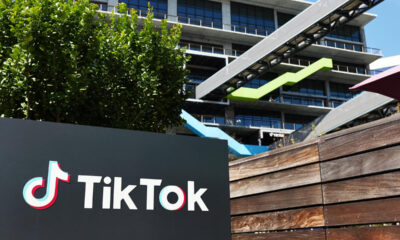Science & Environment
Green farming budget freeze ‘will hit nature and wildlife work’

 Getty Images
Getty ImagesEnvironmental groups have warned that work to boost biodiversity across the UK countryside will be put at risk by the government’s decision to freeze the level of payments to farms in England.
Farmers – already angry at changes to inheritance tax rules announced in the Budget – have been told payments from the public purse will be frozen next year.
The Wildlife Trusts say the decision leaves a “monumental gap” between current environmental land management scheme (Elms) funding and what is needed to help farmers protect and boost wildlife and its habitats, while still producing food.
The government said it would maintain the £2.4bn current level of farm payments in England for 2025/26, and that its commitment to farming was “steadfast”.
 James Grindal
James GrindalOne farmer told the BBC he no longer believed the government understood the pressures of producing the nation’s food and protecting the countryside.
James Grindal, a mixed arable and livestock farmer in Leicestershire, said: “I wouldn’t think the government has any idea.
“I think they ought to come and see the reality – the coalface of putting food on people’s plates.”
In Wednesday’s Budget, the Chancellor announced that, while there would continue to be no inheritance tax due on combined business and agricultural assets worth less than £1m, above that there would be a 50% relief, at an effective rate of 20%, from April 2026.
While some maintain the new policy is designed in part to cover large-scale landowners who may have invested in farmland for the tax benefit, many in farming say the £1m limit will hit small family farms hardest.
Mr Grindal, who has two sons, aged 17 and 19, said he could be hit twice by the changes – on handing down the family farm, and if landowners sell off the land he rents.
 CLA
CLA“I explained to my youngest son, who asked what the implications were, that if you take 20% off something every time someone dies, it’s not long before you get to nought,” he said.
“The Chancellor said she wants to protect small farms, but she is protecting the person who made a lot of money somewhere, bought a nice house with 20, 30, 50 acres to have a few horses on.”
Liberal Democrat environment spokesman Tim Farron said of the changes to agricultural property inheritance tax relief: “This is a family farm tax which risks ringing the death knell for local farmers and the small businesses who rely on them.”
Conservationists and environmental groups have spoken out on the government’s plans to maintain the farming payments budget at its current annual level of £2.4bn, the majority of which goes on environmental land management schemes.
The Wildlife Trusts said around £3.1bn was needed for environmental farming schemes in England, and that maintaining the budget at current levels was a real-terms cut.
‘Largest ever budget’
Elliot Chapman-Jones, the Trusts’ head of public affairs, said: “Ultimately, there is a monumental gap between current funding and what is needed to reverse wildlife declines, clean up rivers and significantly reduce the use of chemicals on farms.”
Tom Lancaster, land, food and farming analyst at the Energy and Climate Intelligence Unit think tank, said all the budget did was “maintain the status quo, just about keeping the show on the road for now”.
The Country Land and Business Association’s (CLA) president Victoria Vyvyan said the decision to freeze the budget at the same level would hit hard-pressed farmers.
She added: “It could hit sustainable food production and undermine improvements to wildlife habitats, flood management and access to nature.”
The government said the £2.4bn farming budget for England in 2025/26 would still be the “largest ever budget directed at sustainable food production and nature’s recovery”.
Minister for Food Security and Rural Affairs Daniel Zeichner said: “Our commitment to farmers and the vital role they play to feed our nation remains steadfast.
“That is why this government will commit to the largest ever budget directed at sustainable food production and nature’s recovery in our country’s history, enabling us to keep momentum on the path to a more resilient and sustainable farming sector.”
Science & Environment
Quantum batteries could give off more energy than they store

Simulations suggest that when a quantum battery shares a quantum state with the device it is powering, the device can gain more charge than was stored in the battery to begin with
Source link
Science & Environment
Oil giant Shell posts small drop in third-quarter profit to $6 billion

The Shell logo is displayed outside a petrol station in Radstock in Somerset, England, on Feb. 17, 2024.
Matt Cardy | Getty Images News | Getty Images
British oil giant Shell on Thursday posted a small year-on-year drop to a stronger-than-expected third-quarter profit, partly owing to a sharp drop in crude prices and to lower refining margins.
The energy company reported adjusted earnings of $6 billion for the July-September period, beating analyst expectations of $5.3 billion, according to estimates compiled by LSEG.
Shell posted adjusted earnings of $6.3 billion in the second quarter and $6.2 billion in the third quarter of 2023.
Shell said it will buy back a further $3.5 billion of its shares over the next three months, while holding its dividend unchanged at 34 cents per share.
Net debt came in at $35.2 billion at the end of the third quarter, down from $40.5 billion when compared to the same period last year.
Shares of the London-listed firm have fallen around 3% year-to-date.
Ahead of the firm’s third-quarter earnings, Shell warned that refining profit margins had dropped by more than 28% on a quarterly basis, while trading results for its chemicals and oil products division were expected to be lower.
British rival BP on Tuesday posted its weakest quarterly earnings in nearly four years, weighed down by lower refining margins.
BP reported underlying replacement cost profit, used as a proxy for net profit, of $2.3 billion for the third quarter. That beat analyst expectations — but reflected a steep drop when compared to the same period a year earlier.
Oil prices tumbled over 17% in the third quarter amid concerns over the outlook for global oil demand.
Science & Environment
Chinese EV maker BYD’s quarterly sales overtook Tesla’s for the first time
New cars, among them new China-built electric vehicles of the company BYD, are seen parked in the port of Zeebrugge, Belgium, October 24, 2024.
Yves Herman | Reuters
Chinese electric vehicle maker BYD reported third-quarter revenue that topped that of behemoth rival Tesla for the first time.
On Wednesday, BYD reported revenue for the three months ended Sept. 30 of 201.12 billion yuan ($28.24 billion), up 24% from a year ago. That exceeded Tesla’s revenue of $25.18 billion reported for the same period.
It’s a first for the Beijing-based EV giant as its solid performance came despite the EV downtrend in mainland China. The company sold a record number of passenger vehicles in August.
At least half of BYD’s sales are hybrid vehicles, whereas Tesla’s vehicles are battery only.
But in terms of net profit, Tesla still took the lead.
The American carmaker saw net profit of $2.18 billion from July to September, up 16.2% from a year ago. Its Chinese counterpart, BYD, saw an increase in profit of 11.5% in the same period to 11.6 billion yuan.
Likewise, Tesla remains on top in year-to-date sales, slightly edging out BYD’s roughly $70.53 billion total revenue at $71.98 billion.
BYD is one of the most prominent EV makers in China, the world’s largest automotive market where it must contend with both domestic and global rivals for dominance.
On BYD’s home turf, Elon Musk’s Tesla is one of its toughest competitors. The Model Y remained the best-selling battery-powered electric car in China in September, according to Chinese automotive website Autohome. BYD’s Seagull trailed closely behind in second place.
The competition will likely only get more cut-throat as European Union tariffs came into effect this week, despite China’s disapproval.
On Wednesday, the EU announced it would implement tariff increases on Chinese EVs, taking duties to as high as 45.3%.
The extra tariffs range from 7.8% for Tesla to 35.3% for SAIC Motors, which will stack on top of a 10% standard import duty on all electric vehicles.

While tariffs imposed on BYD and Tesla were reduced from an earlier proposal, both automakers have taken steps to ramp up production in Europe which would help them work around the duties.
Reuters reported earlier this month that Tesla got the green light to double the capacity of its Berlin plant.
And BYD announced last year it would set up shop in Hungary. In July, the Chinese automaker said it would invest $1 billion into a plant in Turkey, which has a customs union with the EU.
— CNBC’s Evelyn Cheng contributed to this report.
Science & Environment
China declares success as its youngest astronauts reach space

A Chinese spacecraft with a three-person crew, including the country’s first female space engineer, has docked after a journey of more than six hours.
The crew will use the homegrown space station as a base for six months to conduct experiments and carry out spacewalks as Beijing gathers experience and intelligence for its eventual mission to put someone on the Moon by 2030.
Beijing declared the launch of Shenzhou 19 a “complete success” – it is one of 100 launches China has planned in a record year of space exploration as it tries to outdo its rival, the United States.
The BBC was given rare access to the Jiuquan Satellite launch centre in Gansu and we were just over a kilometre away when the spacecraft blasted off.
Flames shot out of the rocket launcher as it took to the skies, lighting up the Gobi Desert with a deafening roar.
Hundreds of people lined the streets, waving and cheering the names of the taikonauts, China’s word for astronauts, as they were sent off.
At the Tiangong space station, the Shenzhou 19 crew met with three other astronauts who are manning the Shenzhou 18 and will return to Earth on 4 November.
Just two years ago, President Xi Jinping declared that “to explore the vast cosmos, develop the space industry and build China into a space power is our eternal dream”.
But some in Washington see the country’s ambition and fast-paced progress as a real threat.
Earlier this year, Nasa chief Bill Nelson said the US and China were “in effect, in a race” to return to the Moon, where he fears Beijing wants to stake territorial claims.
He told legislators that he believed their civilian space programme was also a military programme.
 CCTV
CCTV‘Dreams that spark glory’
However, in Dongfeng Space City, a town built to support the launch site, China’s space programme is celebrated.
Every street light is adorned with the national flag.
Cartoon-like astronaut figurines and sculptures sit in the centre of children’s parks and plastic rockets are a centrepiece on most traffic roundabouts.
A huge poster with Xi Jinping on one side and a photo of the Shenzhou spacecraft on the other greets you as you drive into the main compound.
Hundreds have gathered in the dark after midnight to wave flags and brightly coloured lights as the Taikonauts make their last few steps on Earth before heading to the launch site.
The brass band strikes up Ode to the Motherland as young children, kept up late for the occasion, their cheeks adorned with the Chinese flag, all shout in full song.
This is a moment of national pride.
The pilot of this mission, Cai Xuzhe, is a veteran but he’s travelling with a new generation of Chinese-trained taikonauts born in 1990 – including China’s first female space engineer, Wang Haoze.
“Their youthful energy has made me feel younger and even more confident,” he told the gathered media ahead of take-off.
“Inspired by dreams that spark glory, and by glory that ignites new dreams, we assure the party and the people that we will stay true to our mission, with our hearts and minds fully devoted. We will strive to achieve new accomplishments in China’s crewed space programme.”
Standing to his left, beaming, is Song Lingdong.
He recalls watching one of China’s first space station missions as a 13-year-old with “excitement and awe”. He chose to become a pilot in the hope that this is how he could serve his country.
All three convey their deep sense of national pride, and state media has emphasised that this will be its “youngest crew” to date.
The message is clear: this is a new generation of space travellers and an investment in the country’s future.
China has already selected its next group of astronauts and they will train for potential lunar missions as well as to crew the space station.
“I am determined not to let down the trust placed in me,” says Mr Song. “I will strive to make our country’s name shine once again in space.”
 EFE
EFEChina’s name has been “shining brightly” a lot lately when it comes to headlines about its space programme.
Earlier this year, the country achieved a historic first by retrieving rock and soil samples from the far side of the Moon.
In 2021, China safely landed a spacecraft on Mars and released its Zhurong rover – becoming just the second nation to do so.
China also has a fleet of satellites in space and has plans for many more.
In August it launched the first 18 of what it hopes will eventually be a constellation of 14,000 satellites providing broadband internet coverage from space, which it hopes will one day rival SpaceX’s Starlink.
Elon Musk, Starlink’s chief executive, admitted on his own platform X that China’s space programme is far more advanced than people realise.
But others in the US are voicing even greater concerns, as they fear this technology can be weaponised.
The head of US Space Command, General Stephen Whiting, told a space symposium in April that China and Russia were both investing heavily in space at a “breath-taking speed”.
He claimed that since 2018, China has tripled the amount of intelligence, surveillance and reconnaissance satellites it has in orbit, building a “kill web over the Pacific Ocean to find, fix, track and target United States and allied military capabilities”.
 BBC/ Xiqing Wang
BBC/ Xiqing WangThe new space race
China’s space exploration is a “collective mission for humanity”, says Li Yingliang, director of the general technology bureau of China’s Manned Space Agency, dismissing US concerns as “unnecessary”.
“I don’t think this should be called a competition… China has long upheld the notion of peaceful use of space in its manned space programme. In the future, we will further develop international co-operation in various aspects of manned space technology, all based on sharing and collaboration,” he adds.
But the new space race is no longer about getting to the Moon. It’s about who will control its resources.
The Moon contains minerals, including rare earths, metals like iron and titanium – and helium too, which is used in everything from superconductors to medical equipment.
Estimates for the value of all this vary wildly, from billions to quadrillions. So it’s easy to see why some see the Moon as a place to make lots of money. However, it’s also important to note that this would be a very long-term investment – and the tech needed to extract and return these lunar resources is some way off, writes the BBC’s science editor Rebecca Morelle.
Chinese experts at the launch centre were keen to point out the benefits of Beijing’s space station experiments.
“We study bones, muscles, nerve cells, and the effects of microgravity on them. Through this research, we’ve discovered that osteoporosis on Earth is actually similar to bone loss in space. If we can uncover unique patterns in space, we might be able to develop special medications to counteract bone loss and muscle atrophy,” said Zhang Wei, from the Chinese Academy of Sciences.
“Many of these experimental results can be applied on Earth.”
China is, at times, trying to downplay its advances.
At the launch of a roadmap for its space ambitions, which include building a research station on the Moon, returning samples of Venus’s atmosphere to Earth and launching more than 30 space missions by the middle of this century, Ding Chibiao from the Chinese Academy of Sciences said the country did not have a great number of achievements “compared to developed nations”.
 BBC/ Xiqing Wang
BBC/ Xiqing WangAnd even here at the launch centre, they admit to “significant challenges” as they try to land a crew on the Moon.
“The technology is complex, there’s a tight schedule, and there are a lot of challenges,” said Lin Xiqiang, spokesperson for the China Manned Space Agency.
“We’ll keep up the spirit of ‘two bombs and one star’. We will maintain our self-confidence and commitment to self-improvement, keep working together and keep pushing forward. We’ll make the Chinese people’s dream of landing on the Moon a reality in the near future.”
That’s perhaps why President Xi appears to be prioritising the country’s space programme even as the economy is in a slow decline.
And even though they are bringing along international press to witness their progress – there are key restrictions.
We were kept in a hotel three hours from the launch site and transported back and forth by bus, a total journey of 12 hours, rather than being left on site for a few hours.
A simple trip to a friendly local restaurant was carefully guarded by a line of security personnel.
We also noticed a large sign in town holds a stern warning: “It’s a crime to leak secrets. It’s an honour to keep secrets. You’ll be jailed if you leak secrets. You’ll be happy if you keep secrets. You’ll be shot if you sell secrets.”
China is taking no chances with its new technology, as its rivalry with the United States is no longer just here on Earth.
The world’s two most powerful countries could soon be staking territorial claims well beyond this planet.
Science & Environment
Deadliest weather made worse by climate change, report says

 Getty Images
Getty ImagesHuman-caused climate change made the ten deadliest extreme weather events of the last 20 years more intense and more likely, according to new analysis.
The killer storms, heatwaves and floods affected Europe, Africa and Asia killing more than 570,000 people.
The new analysis highlights how scientists can now discern the fingerprint of climate change in complex weather events.
The study involved reanalysing data for some of the extreme weather events and was carried out by scientists from the World Weather Attribution (WWA) group at Imperial College London.
“This study should be an eye-opener for political leaders hanging on to fossil fuels that heat the planet and destroy lives”, said Dr Friederike Otto, co-founder and lead of WWA.
“If we keep burning oil, gas and coal, the suffering will continue,” she said.
 Getty Images
Getty ImagesThe researchers focused on the 10 deadliest weather events registered in the International Disaster Database since 2004. That was when the first study was published linking a weather event – a heatwave in Europe – with our changing climate.
The deadliest event of the last two decades was a drought in Somalia in 2011 which is reckoned to have killed more than 250,000 people. The researchers found the low rainfall that drove the drought was made more likely and more extreme by climate change.
The list includes the heatwave that hit France in 2015 killing more than 3,000 people, where researchers say high temperatures were made twice as likely because of climate change.
It also contains the European heatwaves of 2022, when 53,000 people died, and 2023, which led to 37,000 people losing their lives. The latter would have been impossible without climate change, the study finds.
It says the deadly tropical cyclones that hit Bangladesh in 2007, Myanmar in 2008 and the Philippines in 2013 were all made more likely and intense by climate change. That was also the case with the floods that hit India in 2013.
The researchers say the real death toll from these events is likely to be significantly higher than the figures they quote.
That is because fatalities linked to heatwaves do not tend to be recorded as such in much of the world, especially in poorer nations which are most vulnerable.
The study was carried out before the storms in Spain left dozens dead this week.
 Getty Images
Getty ImagesThe link between climate change and weather events is only possible because the two scientists who founded the WWA – Dr Otto and a Dutch climatologist called Geert Jan van Oldenborgh – pioneered a way to track global warming in catastrophic weather events.
They knew that weather records showed that extreme weather events were becoming more intense. What’s more, a huge body of peer-reviewed science explained how warming the atmosphere can intensify extreme weather. What was missing was the link between a single event to rising global temperatures.
For years forecasters have been using atmospheric models to predict future weather patterns. Otto and Oldenborgh repurposed the models to run repeated simulations to work out how likely a weather event was in the current climate.
They also created parallel simulations which explored how likely the same event was in a world in which the industrial revolution had never happened. These computer models stripped out the effects of the billions of tonnes of CO2 that humans have pumped into the atmosphere.
The calculations meant they could compare how likely the same event was with and without the 1.2C of global warming that the world has already experienced since the industrial revolution.
“The massive death tolls we keep seeing in extreme weather shows we are not well prepared for 1.3°C of warming, let alone 1.5°C or 2°C”, said Roop Singh, of the Red Cross Red Crescent Climate Centre which supports the WWA.
She said today’s study showed the need for all countries to build their resilience to climate change and warned: “With every fraction of a degree of warming, we will see more record-breaking events that push countries to the brink, no matter how prepared they are.”
Science & Environment
FTX’s Nishad Singh gets not jail time, 3 years supervised release

Nishad Singh, former director of Engineering at FTX Cryptocurrency Derivatives Exchange, left, and Claire Watanabe, former senior executive at FTX Cryptocurrency Derivatives Exchange, arrive at court in New York, on Oct. 30, 2024.
Mackenzie Sigalos | CNBC
Former FTX executive Nishad Singh was sentenced to time served and three years of supervised release on Wednesday, becoming the fourth ex-employee of the collapsed crypto exchange to be punished. Singh was also ordered to forfeit $11 billion.
Singh faced a maximum sentence of 75 years but New York Judge Lewis Kaplan noted his cooperation with the government as “remarkable” and said he was entirely persuaded that Singh’s involvement with the fraud was far more limited than that of FTX founder Sam Bankman-Fried or Caroline Ellison, the former CEO of sister hedge fund Alameda Research.
Ellison was the star witness in the prosecution of Bankman-Fried and recently received a two-year prison sentence.
Singh, who was FTX’s head of engineering, pleaded guilty early last year to six criminal charges, including conspiracy to commit securities fraud, conspiracy to commit money laundering and conspiracy to violate campaign finance laws.
On Wednesday, Singh delivered a statement to the Court and said in a soft voice that he had strayed from his values and didn’t expect forgiveness. He said that assisting in the government’s investigation gave him purpose. Just before the hearing began, Singh was alone, pacing the elevator bank, as he rehearsed his statement from a single printed page.
FTX spiraled into bankruptcy in Nov. 2022, after the crypto exchange couldn’t meet customers’ withdrawal demands and allegedly stole $8 billion in client funds. In March, Bankman-Fried was sentenced to 25 years in prison and ordered to pay $11 billion.
Andrew Goldstein, Singh’s attorney and a former assistant U.S. attorney for the Southern District of New York, said that Singh became a participant in FTX’s wrongdoing at a very late stage and cited his extensive cooperation with the government, including testifying at Bankman-Fried’s trial last year.
Prosecutors noted that they met with Singh on at least 24 occasions for multiple hours and that he demonstrated “earnest remorse and eagerness to assist,” as well as “brought to the Government’s attention criminal conduct that the Government was not aware of and, in some cases, may have never discovered but for Singh’s cooperation.”
Nicolas Roos, one of the prosecutors in the trial, noted that the campaign finance scheme was “totally unknown” by the government and that Singh had “exclusively brought” details of the arrangement to the government.
Ross told Judge Kaplan that leniency “would send an important message.”
In Kaplan’s reading of the sentencing, he told the defendant, “You did the right thing.”
More than 30 of Singh’s friends and family members filled the pews of courtroom on the 21st floor of the Manhattan courthouse. His fiancee, parents and brothers were seated together in the front row.
More than 100 people submitted letters on Singh’s behalf, including one from Bankman-Fried’s brother, Gabe, who called him “one of the kindest people [he has] ever known.” He asked Judge Kaplan to show Singh “the same compassion he has shown others his entire life.”
John Ray, who took over as FTX CEO after the bankruptcy filing in 2022, also submitted a letter on Singh’s behalf, saying he had provided the debtors with valuable assistance and cooperation throughout the bankruptcy proceedings. Ray said Singh made substantial productions of documents, and he voluntarily returned Bahamian real estate purchased with FTX funds.
Ryan Salame, another former top lieutenant of Bankman-Fried, was sentenced to seven and a half years in prison in May. Gary Wang, the co-founder and ex-technology chief of FTX, will be sentenced Nov. 20.
— CNBC’s Dan Mangan contributed to this report.
WATCH: Caroline Ellison sentenced to two years in prison for role in FTX collapse

-

 Science & Environment1 month ago
Science & Environment1 month agoHow to unsnarl a tangle of threads, according to physics
-

 Technology1 month ago
Technology1 month agoIs sharing your smartphone PIN part of a healthy relationship?
-

 Science & Environment1 month ago
Science & Environment1 month agoHyperelastic gel is one of the stretchiest materials known to science
-

 Science & Environment1 month ago
Science & Environment1 month ago‘Running of the bulls’ festival crowds move like charged particles
-

 Technology1 month ago
Technology1 month agoWould-be reality TV contestants ‘not looking real’
-

 Science & Environment1 month ago
Science & Environment1 month agoMaxwell’s demon charges quantum batteries inside of a quantum computer
-

 Science & Environment1 month ago
Science & Environment1 month agoX-rays reveal half-billion-year-old insect ancestor
-

 Science & Environment1 month ago
Science & Environment1 month agoSunlight-trapping device can generate temperatures over 1000°C
-

 Technology1 month ago
Technology1 month agoUkraine is using AI to manage the removal of Russian landmines
-

 Technology4 weeks ago
Technology4 weeks agoGmail gets redesigned summary cards with more data & features
-

 Football4 weeks ago
Football4 weeks agoRangers & Celtic ready for first SWPL derby showdown
-

 Sport4 weeks ago
Sport4 weeks agoBoxing: World champion Nick Ball set for Liverpool homecoming against Ronny Rios
-

 Science & Environment1 month ago
Science & Environment1 month agoLaser helps turn an electron into a coil of mass and charge
-

 Science & Environment1 month ago
Science & Environment1 month agoLiquid crystals could improve quantum communication devices
-

 Technology1 month ago
Technology1 month agoRussia is building ground-based kamikaze robots out of old hoverboards
-

 Science & Environment1 month ago
Science & Environment1 month agoPhysicists have worked out how to melt any material
-

 Science & Environment1 month ago
Science & Environment1 month agoQuantum ‘supersolid’ matter stirred using magnets
-

 Technology4 weeks ago
Technology4 weeks agoSamsung Passkeys will work with Samsung’s smart home devices
-

 TV4 weeks ago
TV4 weeks agoসারাদেশে দিনব্যাপী বৃষ্টির পূর্বাভাস; সমুদ্রবন্দরে ৩ নম্বর সংকেত | Weather Today | Jamuna TV
-

 Sport4 weeks ago
Sport4 weeks agoAaron Ramsdale: Southampton goalkeeper left Arsenal for more game time
-

 MMA4 weeks ago
MMA4 weeks agoDana White’s Contender Series 74 recap, analysis, winner grades
-

 MMA4 weeks ago
MMA4 weeks ago‘Uncrowned queen’ Kayla Harrison tastes blood, wants UFC title run
-

 Science & Environment1 month ago
Science & Environment1 month agoA new kind of experiment at the Large Hadron Collider could unravel quantum reality
-

 Technology4 weeks ago
Technology4 weeks agoEpic Games CEO Tim Sweeney renews blast at ‘gatekeeper’ platform owners
-

 News4 weeks ago
News4 weeks ago‘Blacks for Trump’ and Pennsylvania progressives play for undecided voters
-

 Money4 weeks ago
Money4 weeks agoWetherspoons issues update on closures – see the full list of five still at risk and 26 gone for good
-

 News4 weeks ago
News4 weeks agoNavigating the News Void: Opportunities for Revitalization
-

 News4 weeks ago
News4 weeks agoWoman who died of cancer ‘was misdiagnosed on phone call with GP’
-

 Technology1 month ago
Technology1 month agoWhy Machines Learn: A clever primer makes sense of what makes AI possible
-

 News4 weeks ago
News4 weeks agoMassive blasts in Beirut after renewed Israeli air strikes
-

 News1 month ago
News1 month agoRwanda restricts funeral sizes following outbreak
-

 Technology4 weeks ago
Technology4 weeks agoMicrosoft just dropped Drasi, and it could change how we handle big data
-

 News4 weeks ago
News4 weeks ago▶ Hamas Spent $1B on Tunnels Instead of Investing in a Future for Gaza’s People
-

 Football4 weeks ago
Football4 weeks agoWhy does Prince William support Aston Villa?
-

 MMA4 weeks ago
MMA4 weeks agoPereira vs. Rountree prediction: Champ chases legend status
-

 Business4 weeks ago
Business4 weeks agoWhen to tip and when not to tip
-

 MMA4 weeks ago
MMA4 weeks ago‘Dirt decision’: Conor McGregor, pros react to Jose Aldo’s razor-thin loss at UFC 307
-

 Science & Environment1 month ago
Science & Environment1 month agoWhy this is a golden age for life to thrive across the universe
-

 Technology4 weeks ago
Technology4 weeks agoMusk faces SEC questions over X takeover
-

 Technology1 month ago
Technology1 month agoMicrophone made of atom-thick graphene could be used in smartphones
-

 Sport4 weeks ago
Sport4 weeks agoChina Open: Carlos Alcaraz recovers to beat Jannik Sinner in dramatic final
-

 Sport4 weeks ago
Sport4 weeks ago2024 ICC Women’s T20 World Cup: Pakistan beat Sri Lanka
-

 Sport4 weeks ago
Sport4 weeks agoWales fall to second loss of WXV against Italy
-

 Science & Environment1 month ago
Science & Environment1 month agoITER: Is the world’s biggest fusion experiment dead after new delay to 2035?
-

 Science & Environment1 month ago
Science & Environment1 month agoA slight curve helps rocks make the biggest splash
-

 Womens Workouts1 month ago
Womens Workouts1 month ago3 Day Full Body Women’s Dumbbell Only Workout
-

 Science & Environment1 month ago
Science & Environment1 month agoQuantum forces used to automatically assemble tiny device
-

 Science & Environment1 month ago
Science & Environment1 month agoNuclear fusion experiment overcomes two key operating hurdles
-

 News2 months ago
News2 months ago▶️ Hamas in the West Bank: Rising Support and Deadly Attacks You Might Not Know About
-
Business4 weeks ago
DoJ accuses Donald Trump of ‘private criminal effort’ to overturn 2020 election
-

 News4 weeks ago
News4 weeks agoCornell is about to deport a student over Palestine activism
-

 Technology4 weeks ago
Technology4 weeks agoCheck, Remote, and Gusto discuss the future of work at Disrupt 2024
-
Business4 weeks ago
how UniCredit built its Commerzbank stake
-

 MMA4 weeks ago
MMA4 weeks agoKayla Harrison gets involved in nasty war of words with Julianna Pena and Ketlen Vieira
-

 MMA4 weeks ago
MMA4 weeks ago‘I was fighting on automatic pilot’ at UFC 306
-

 Technology1 month ago
Technology1 month agoMeta has a major opportunity to win the AI hardware race
-
Business4 weeks ago
Bank of England warns of ‘future stress’ from hedge fund bets against US Treasuries
-

 News4 weeks ago
News4 weeks agoHull KR 10-8 Warrington Wolves – Robins reach first Super League Grand Final
-

 MMA4 weeks ago
MMA4 weeks agoKetlen Vieira vs. Kayla Harrison pick, start time, odds: UFC 307
-

 Sport4 weeks ago
Sport4 weeks agoCoco Gauff stages superb comeback to reach China Open final
-

 Sport4 weeks ago
Sport4 weeks agoMan City ask for Premier League season to be DELAYED as Pep Guardiola escalates fixture pile-up row
-

 Business4 weeks ago
Business4 weeks agoWater companies ‘failing to address customers’ concerns’
-

 News4 weeks ago
News4 weeks agoGerman Car Company Declares Bankruptcy – 200 Employees Lose Their Jobs
-

 Football4 weeks ago
Football4 weeks ago'Rangers outclassed and outplayed as Hearts stop rot'
-

 Sport4 weeks ago
Sport4 weeks agoWXV1: Canada 21-8 Ireland – Hosts make it two wins from two
-
Business4 weeks ago
Sterling slides after Bailey says BoE could be ‘a bit more aggressive’ on rates
-

 Technology4 weeks ago
Technology4 weeks agoTexas is suing TikTok for allegedly violating its new child privacy law
-

 Sport4 weeks ago
Sport4 weeks agoSturm Graz: How Austrians ended Red Bull’s title dominance
-
Business4 weeks ago
The search for Japan’s ‘lost’ art
-

 Technology4 weeks ago
Technology4 weeks agoLG C4 OLED smart TVs hit record-low prices ahead of Prime Day
-

 Technology4 weeks ago
Technology4 weeks agoIf you’ve ever considered smart glasses, this Amazon deal is for you
-

 Science & Environment1 month ago
Science & Environment1 month agoTime travel sci-fi novel is a rip-roaringly good thought experiment
-

 Science & Environment1 month ago
Science & Environment1 month agoNerve fibres in the brain could generate quantum entanglement
-

 Technology1 month ago
Technology1 month agoUniversity examiners fail to spot ChatGPT answers in real-world test
-

 News4 weeks ago
News4 weeks agoFamily plans to honor hurricane victim using logs from fallen tree that killed him
-

 Sport4 weeks ago
Sport4 weeks agoPremiership Women’s Rugby: Exeter Chiefs boss unhappy with WXV clash
-

 Entertainment4 weeks ago
Entertainment4 weeks agoNew documentary explores actor Christopher Reeve’s life and legacy
-

 Business1 month ago
Business1 month agoStocks Tumble in Japan After Party’s Election of New Prime Minister
-

 Technology4 weeks ago
Technology4 weeks agoSingleStore’s BryteFlow acquisition targets data integration
-

 Technology4 weeks ago
Technology4 weeks agoOpenAI secured more billions, but there’s still capital left for other startups
-

 Money4 weeks ago
Money4 weeks agoPub selling Britain’s ‘CHEAPEST’ pints for just £2.60 – but you’ll have to follow super-strict rules to get in
-

 Entertainment4 weeks ago
Entertainment4 weeks agoBruce Springsteen endorses Harris, calls Trump “most dangerous candidate for president in my lifetime”
-

 News1 month ago
News1 month ago▶️ Media Bias: How They Spin Attack on Hezbollah and Ignore the Reality
-

 Science & Environment1 month ago
Science & Environment1 month agoHow to wrap your mind around the real multiverse
-

 MMA4 weeks ago
MMA4 weeks agoJulianna Peña trashes Raquel Pennington’s behavior as champ
-
Business4 weeks ago
Top shale boss says US ‘unusually vulnerable’ to Middle East oil shock
-

 Technology4 weeks ago
Technology4 weeks agoThis AI video generator can melt, crush, blow up, or turn anything into cake
-

 Technology4 weeks ago
Technology4 weeks agoJ.B. Hunt and UP.Labs launch venture lab to build logistics startups
-
Politics4 weeks ago
Rosie Duffield’s savage departure raises difficult questions for Keir Starmer. He’d be foolish to ignore them | Gaby Hinsliff
-

 Technology4 weeks ago
Technology4 weeks agoThe best budget robot vacuums for 2024
-

 Business4 weeks ago
Business4 weeks agoChancellor Rachel Reeves says she needs to raise £20bn. How might she do it?
-

 Technology4 weeks ago
Technology4 weeks agoAmazon’s Ring just doubled the price of its alarm monitoring service for grandfathered customers
-

 Technology4 weeks ago
Technology4 weeks agoApple iPhone 16 Plus vs Samsung Galaxy S24+
-
Business4 weeks ago
Head of UK Competition Appeal Tribunal to step down after rebuke for serious misconduct
-

 Technology4 weeks ago
Technology4 weeks agoThe best shows on Max (formerly HBO Max) right now
-

 Money3 weeks ago
Money3 weeks agoTiny clue on edge of £1 coin that makes it worth 2500 times its face value – do you have one lurking in your change?
-

 Sport1 month ago
Sport1 month agoWorld’s sexiest referee Claudia Romani shows off incredible figure in animal print bikini on South Beach
-

 TV4 weeks ago
TV4 weeks agoTV Patrol Express September 26, 2024
-

 MMA4 weeks ago
MMA4 weeks agoPennington vs. Peña pick: Can ex-champ recapture title?
-

 MMA4 weeks ago
MMA4 weeks agoUFC 307 preview show: Will Alex Pereira’s wild ride continue, or does Khalil Rountree shock the world?


You must be logged in to post a comment Login